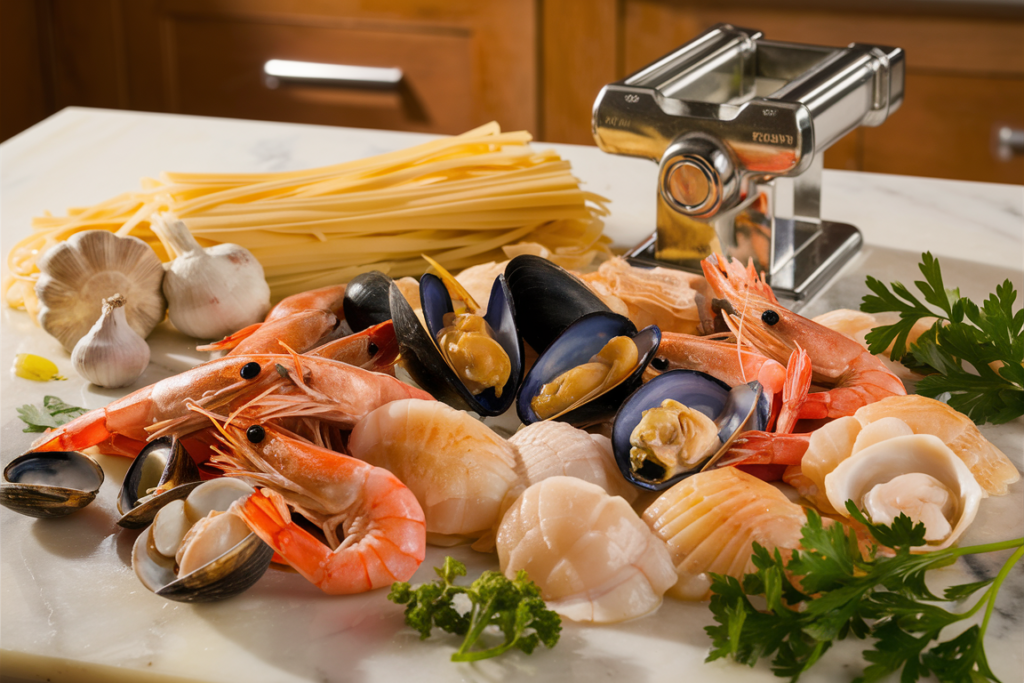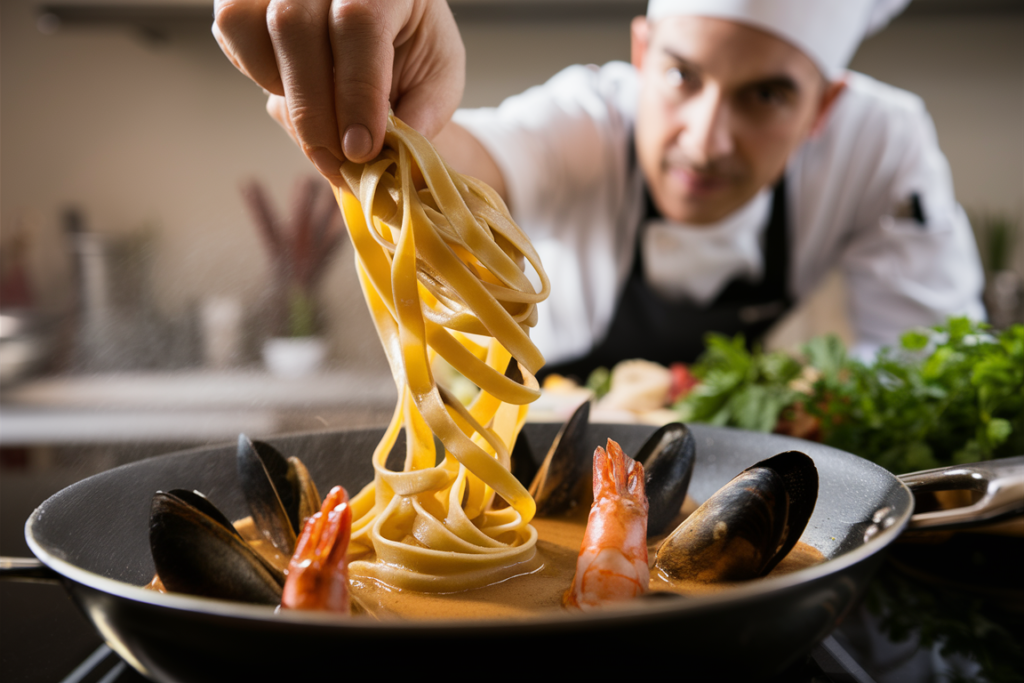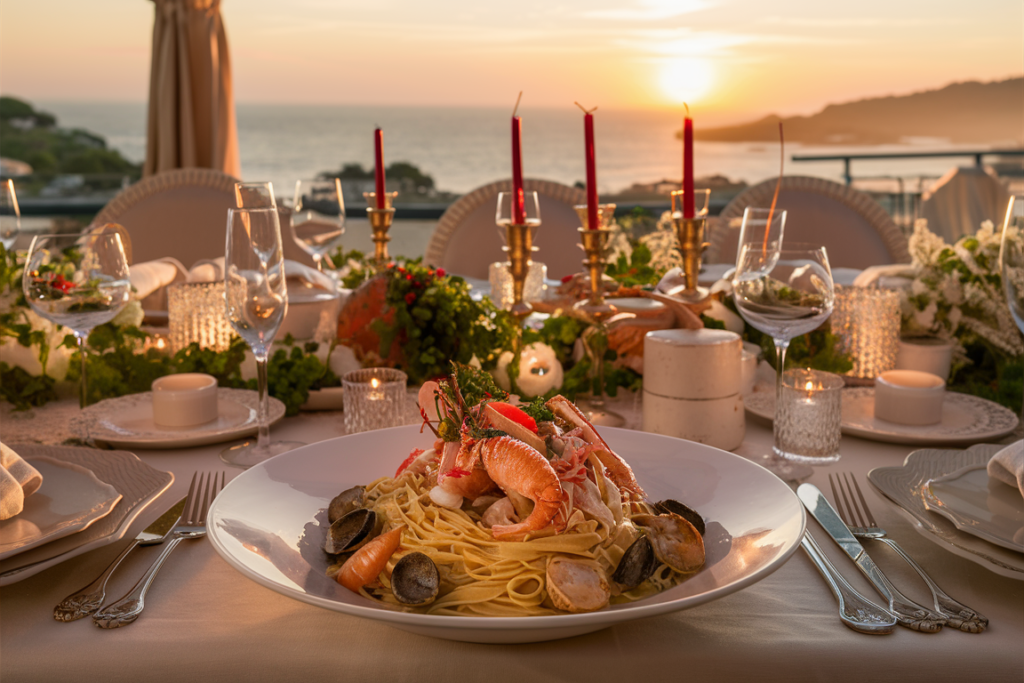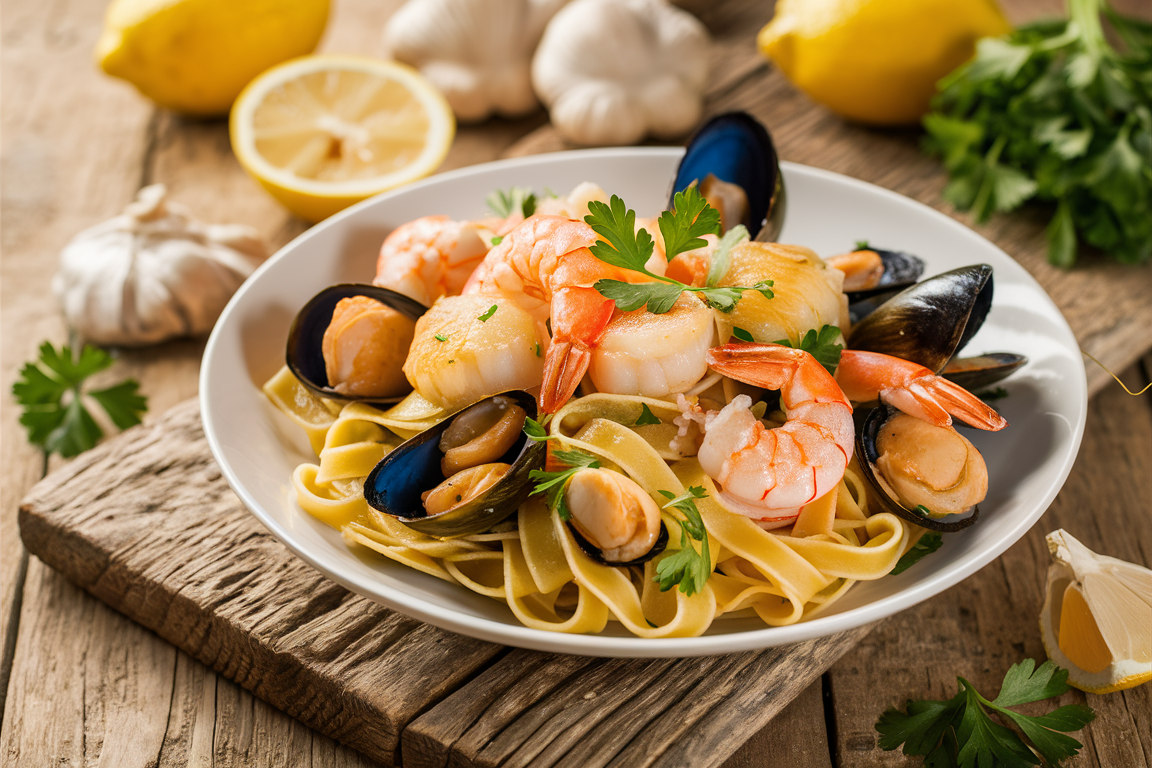Part 1: Exploring the World of Seafood Tagliatelle Pasta
Seafood Tagliatelle Pasta is a culinary masterpiece that seamlessly blends the silken texture of tagliatelle with the delicate flavors of fresh seafood. Moreover, this dish has won hearts across the globe due to its versatility, nutritional value, and rich cultural roots. In this guide, we will not only delve into its history but also explore its key ingredients, variations, and essential cooking techniques.

What is Seafood Tagliatelle Pasta?
Seafood Tagliatelle Pasta is a dish that beautifully combines long, flat ribbons of tagliatelle with succulent seafood, which is typically tossed in a flavorful sauce to enhance its rich, savory profile. Originally hailing from Italy, it beautifully showcases the country’s passion for fresh, high-quality ingredients. Furthermore, from Mediterranean flavors to global interpretations, this dish is cherished not only for its simplicity but also for its elegance.
The foundation of this dish lies in its balance of textures and flavors. The smooth pasta complements the tender seafood, creating a harmony that’s both satisfying and light.
Historical Background
The roots of Seafood Tagliatelle Pasta can be traced back to Italy, a nation renowned for its cuisine, where pasta and seafood have long been culinary staples that define its coastal traditions. In particular, this pairing gained popularity in coastal regions, as fresh catches of shrimp, clams, and mussels were readily available. Over the years, this dish gradually evolved into a beloved symbol of Italian coastal cuisine.
During the Renaissance, pasta gained prominence as a luxury item, and seafood dishes became a centerpiece of Italian feasts. Today, the combination of tagliatelle and seafood represents both a connection to tradition and a canvas for modern culinary innovation.
Popularity Across the Globe
Seafood Tagliatelle has transcended its Italian origins, becoming a global favorite. In France, it is often infused with creamy sauces, while in Asia, chefs incorporate local seafood and spices for a fusion twist. This dish’s adaptability has made it a staple on menus worldwide, from upscale restaurants to cozy home kitchens.
One popular variation, for example, is the Mediterranean-style tagliatelle, which features olive oil, garlic, and lemon. This combination beautifully reflects the region’s reliance on fresh, simple ingredients.
Types of Seafood Commonly Used
Seafood Tagliatelle thrives on fresh, high-quality ingredients. Here are some popular seafood choices:
- Shrimp: Adds sweetness and texture.
- Scallops: Provide a buttery richness.
- Mussels and Clams: Bring a briny, oceanic flavor.
- Lobster or Crab: Elevate the dish with luxury.
- White Fish: Offers a mild, flaky element.
The choice of seafood often depends on regional availability and personal preference.
Tagliatelle: The Perfect Pasta for Seafood
Tagliatelle’s broad, flat ribbons make it ideal for holding sauces, thereby ensuring that every bite is bursting with flavor. Furthermore, made from eggs and flour, its silky texture perfectly complements the tender bite of seafood.
Compared to other pasta shapes, tagliatelle has the advantage of:
- Absorbing sauces evenly.
- Pairing well with chunky ingredients like shrimp or clams.
- Offering a hearty but refined base for elaborate seafood dishes.
Nutritional Value of Seafood Tagliatelle Pasta
This dish is not only delicious but also nutritious. Key benefits include:
- Protein: Seafood is a lean protein source, aiding muscle repair and overall health.
- Omega-3 Fatty Acids: Found in fish and shellfish, these promote heart and brain health.
- Complex Carbohydrates: Tagliatelle provides sustained energy.
- Vitamins and Minerals: Seafood is rich in zinc, iodine, and vitamin B12.
For those seeking a healthier twist, whole-grain tagliatelle or zucchini noodles are excellent options.
Key Ingredients
Achieving the perfect Seafood Tagliatelle Pasta requires the following:
Fresh Seafood: Shrimp, scallops, mussels, or clams are essential for creating a dish bursting with oceanic flavors.
Tagliatelle: Whether homemade for a personal touch or store-bought for convenience, this pasta provides the perfect base.
Aromatics: Garlic, onions, and fresh herbs like parsley or basil add depth and enhance the overall taste.
Sauces: Options like olive oil, white wine, or cream-based sauces offer versatility and richness to complement the seafood.
Seasonings: Simple yet impactful, salt, pepper, and a splash of lemon juice bring brightness and balance to the dish.
Each ingredient plays a crucial role in creating a dish that’s both flavorful and cohesive.
Different Variations of Seafood Tagliatelle Pasta
From classic recipes to modern interpretations, the possibilities are truly endless. For example, here are some popular variations to inspire your next dish:
- Creamy Garlic Seafood Tagliatelle: A rich and indulgent option, perfect for those seeking a decadent meal.
- Spicy Tomato Tagliatelle: A bold variation featuring a kick of chili for lovers of fiery flavors.
- Lemon Herb Tagliatelle: Light and refreshing, making it an ideal choice for summer dining.
- Seafood Carbonara: A creative fusion twist that combines the luxuriousness of seafood with a creamy, egg-based sauce.
These variations cater to a range of palates and occasions.
Equipment Needed for Cooking
Creating this dish successfully requires a few essential tools to ensure ease and precision in the kitchen:
- Pasta Maker: Ideal for crafting homemade tagliatelle, adding a personal touch to your dish.
- Large Pots: Necessary for boiling pasta and steaming seafood to perfection.
- Non-Stick Pan: Perfect for sautéing ingredients and combining them seamlessly.
- Tongs: A must-have for efficiently mixing pasta with sauce and ensuring even coating.
- Fine Grater: Great for garnishing with freshly grated Parmesan or vibrant lemon zest.
By investing in quality equipment, you can streamline your cooking process and elevate the final result.
Common Mistakes to Avoid
Even seasoned cooks can face challenges. Avoid these common pitfalls:
- Overcooking Seafood: Leads to rubbery texture.
- Undercooking Pasta: Tagliatelle should be al dente.
- Overloading the Sauce: Overpowers the delicate seafood.
- Using Pre-Cooked Seafood: Compromises flavor and texture.
- Skipping Resting Time: Allow pasta to absorb flavors after mixing.
Mastering these tips guarantees a flawless dish every time.
Part 2: Crafting the Perfect Seafood Tagliatelle Pasta
Creating an unforgettable Seafood Tagliatelle Pasta starts with carefully selecting the freshest ingredients and mastering a few key techniques. By focusing on these fundamentals, you lay the foundation for a dish that is both flavorful and impressive. To start, this process ranges from classic recipes to innovative twists. Moreover, this section covers everything you need to craft a delicious dish that’s sure to impress.
Preparing the Freshest Ingredients
The quality of your ingredients directly impacts the final dish. Here’s how to ensure you’re using the best:
- Seafood: When choosing seafood, always opt for fresh or flash-frozen options. For instance, look for clear eyes on fish, tightly closed shells on mussels and clams, and firm textures in shrimp or scallops. These details ensure the highest quality and best flavor for your dish.
- Pasta: While store-bought tagliatelle works well, homemade pasta offers a luxurious texture and taste. Whole-grain or spinach tagliatelle are excellent for health-conscious variations.
- Aromatics and Herbs: Fresh garlic, onions, parsley, and basil not only play a crucial role in enhancing the dish’s flavor profile but also bring out its aromatic qualities. When incorporated thoughtfully, these ingredients add depth and a burst of freshness to every bite.
- Sauces: For the sauce base, opt for high-quality olive oil, fresh cream, or crushed tomatoes. Each of these options complements the seafood beautifully and provides a rich, flavorful foundation for the dish.

Always ensure seafood is properly cleaned and deveined before use. For sustainability, opt for locally sourced and ethically harvested seafood.
Classic Seafood Tagliatelle Recipe
Ingredients:
- 400g fresh tagliatelle
- 200g shrimp, peeled and deveined
- 150g scallops
- 150g mussels or clams
- 4 cloves garlic, minced
- 2 tbsp olive oil
- 1 cup dry white wine
- 1/4 cup chopped parsley
- Salt and pepper to taste
- Lemon wedges for garnish
Instructions:
- Cook Pasta: Boil tagliatelle in salted water until al dente. Reserve 1 cup of pasta water before draining.
- Sauté Aromatics: Heat olive oil in a pan and sauté garlic until fragrant.
- Cook Seafood: Add shrimp, scallops, and mussels. Pour in wine and cover until mussels open and shrimp turn pink.
- Combine: Once the tagliatelle is cooked, toss it into the pan with the seafood to meld the flavors together. For an ideal texture, add reserved pasta water gradually until you achieve the desired consistency.
- Garnish and Serve: Finally, sprinkle freshly chopped parsley over the dish and serve it with lemon wedges on the side. This finishing touch adds brightness and a hint of zest, elevating the overall presentation and flavor.
This recipe captures the essence of Italian coastal cuisine, highlighting the natural sweetness of seafood.
Creamy Garlic Seafood Tagliatelle
For those seeking a richer dish, this variation features a creamy garlic sauce that not only adds indulgence but also perfectly complements the delicate flavors of seafood.
Ingredients:
- 400g tagliatelle
- 200g shrimp
- 150g scallops
- 3 cloves garlic, minced
- 1 cup heavy cream
- 2 tbsp butter
- 1/2 cup grated Parmesan cheese
- Salt and pepper to taste
Instructions:
- Prepare the pasta as usual.
- Melt butter in a pan, sauté garlic, and add cream.
- Simmer the sauce, stir in Parmesan, and season.
- Cook seafood separately, then combine with the sauce and pasta.
This indulgent dish is perfect for special occasions or cozy dinners.
Spicy Tomato Seafood Tagliatelle
This variation adds a bold kick to the traditional recipe, blending the tangy sweetness of tomatoes with the heat of chili flakes.
Ingredients:
- 400g tagliatelle
- 200g shrimp
- 1 can crushed tomatoes
- 3 cloves garlic, minced
- 2 tbsp olive oil
- 1 tsp red chili flakes
- Fresh basil leaves
Instructions:
- Cook tagliatelle as usual.
- In a pan, heat olive oil and sauté garlic with chili flakes.
- Add crushed tomatoes, simmer, and season.
- Cook shrimp separately, then toss with pasta and sauce.
This fiery twist is ideal for those who enjoy spicy dishes.
Lemon Herb Seafood Tagliatelle
For a lighter option, this version combines zesty lemon and fresh herbs for a refreshing flavor.
Ingredients:
- 400g tagliatelle
- 200g shrimp
- 2 tbsp olive oil
- Zest and juice of 1 lemon
- 1/4 cup chopped parsley and dill
- Salt and pepper
Instructions:
- Prepare pasta as usual.
- Sauté shrimp in olive oil, then toss with lemon zest, juice, and herbs.
- Combine with tagliatelle for a bright, aromatic dish.
Tips for Cooking Seafood Perfectly
Achieving the ideal texture is crucial:
- Shrimp: Cook until pink and opaque. Overcooked shrimp turn rubbery.
- Scallops: Sear for 1–2 minutes per side until golden.
- Mussels and Clams: Discard any shells that don’t open during cooking.
- Timing: Add seafood towards the end to prevent overcooking.
These tips ensure your seafood is tender and flavorful.
How to Make Homemade Tagliatelle Pasta
Fresh pasta elevates this dish. Here’s a simple recipe:
Ingredients:
- 2 cups all-purpose flour
- 3 large eggs
Instructions:
- Form a well in the flour, crack eggs into the center, and mix until dough forms.
- Knead for 10 minutes, wrap in plastic, and rest for 30 minutes.
- Roll out dough and cut into ribbons of tagliatelle.
Sauces that Complement Seafood Tagliatelle
The right sauce enhances the natural flavors of seafood. Popular options include:
- Marinara: A tangy tomato base.
- White Wine Sauce: Light and aromatic.
- Cream-Based: Rich and velvety.
Experimenting with sauces lets you create a unique flavor profile for your dish.
Serving Suggestions and Presentation
A visually appealing plate makes the dish even more enjoyable:
- Garnish with fresh herbs or grated Parmesan.
- Use vibrant ingredients like cherry tomatoes for color.
- Serve with crusty bread and a side salad.
Attention to detail elevates the dining experience.
Pairing Seafood Tagliatelle with Wine
The right wine enhances the dish’s flavors:
- White Wines: Sauvignon Blanc or Chardonnay.
- Sparkling Wines: Prosecco for a celebratory touch.
- Light Reds: Pinot Noir for a bold pairing.
Choosing the right wine adds a sophisticated touch to your meal.
Part 3: Beyond the Basics ( Mastering Seafood Tagliatelle Pasta )
Seafood Tagliatelle Pasta is more than just a dish—it’s a cultural experience. To fully master this dish, one must explore regional variations, advanced techniques, and tips for creating a flawless dining experience. In this section, we delve into the finer points of this beloved recipe, while offering valuable insights for the passionate home chef.
Regional Twists on Seafood Tagliatelle
Italy’s diverse culinary landscape has given rise to unique regional takes on Seafood Tagliatelle Pasta. Here are a few notable variations:
- Venetian Style: Focuses on lagoon-sourced seafood like soft-shell crabs and baby squid, often paired with a light white wine sauce.
- Sicilian Variation: Adds a touch of spice with chili flakes and incorporates tomatoes and olives for a Mediterranean flair.
- Tuscany’s Influence: Combines seafood with earthy ingredients like mushrooms and truffle oil for a decadent twist.
Beyond Italy, global interpretations often feature local seafood and spices, such as Thai-inspired seafood tagliatelle with coconut milk and lemongrass.
The Art of Balancing Flavors
Creating the perfect Seafood Tagliatelle Pasta requires balancing its three key elements:
- Seafood: Ensure the flavor is fresh and not overpowering.
- Pasta: Cooked al dente to complement the texture of the seafood.
- Sauce: Should enhance, not overshadow, the dish’s main components.
Tips for Harmony:
- Use aromatics like garlic and shallots to bridge flavors.
- Add acidity with lemon juice or white wine.
- Season gradually to avoid overpowering the seafood.
Achieving balance elevates the dish from ordinary to restaurant-quality.
How to Store and Reheat Seafood Tagliatelle
Preserving the flavor and texture of leftovers is a common concern. Follow these tips for the best results:
Storage:
- Transfer leftovers to an airtight container and refrigerate within 2 hours of cooking.
- Consume within 2 days for optimal freshness.
Reheating:
- Avoid microwaving, as it can overcook the seafood.
- Instead, reheat gently in a pan with a splash of water or broth.
Proper storage and reheating maintain the dish’s original quality.
Gluten-Free and Vegan Alternatives
Dietary restrictions don’t mean you have to miss out on the deliciousness of Seafood Tagliatelle Pasta. With a few thoughtful adjustments, you can easily adapt the recipe to suit various needs:
Gluten-Free:
- Gluten-Free Pasta Options: Swap traditional tagliatelle for gluten-free alternatives, such as rice-based tagliatelle or zucchini noodles for a lighter option.
- Check Ingredients: Ensure that all sauces and seasonings, including broths or pre-made mixes, are certified gluten-free to avoid hidden sources of gluten.
Vegan:
- Replace seafood with plant-based alternatives like king oyster mushrooms or marinated artichokes.
- Use cashew cream or coconut milk for creamy sauces.
These substitutions offer inclusive variations without compromising flavor.
Seasonal Seafood Guide: Choosing seafood that’s in season ensures the freshest flavors and supports sustainable practices. Here’s a quick breakdown by season:
- Spring: Opt for clams, scallops, and prawns, which are abundant and at their peak freshness during this time.
- Summer: Indulge in lobster and crab, as these luxurious options thrive in the warmer months.
- Fall: Mussels and squid become plentiful, offering rich, briny flavors perfect for heartier dishes.
- Winter: Oysters and white fish are ideal choices, bringing a mild and delicate taste to complement the season’s comforting meals.
By following this guide, you can make the most of each season’s offerings while enhancing the quality of your Seafood Tagliatelle Pasta.vors while supporting ethical fishing practices.
Cost-Effective Tips for a Gourmet Dish
Seafood Tagliatelle Pasta can feel like a luxury, but it doesn’t have to break the bank. Here are some budget-friendly strategies:
- Frozen Seafood: High-quality frozen options often rival fresh seafood in taste.
- Mix and Match: Combine premium ingredients (like scallops) with affordable options (like mussels).
- Homemade Pasta: Making tagliatelle at home is economical and satisfying.
With a little creativity, you can create a gourmet dish on a budget.
Hosting a Seafood Tagliatelle Dinner Party
Impress your guests with a seafood tagliatelle-themed dinner party that combines delicious food with a delightful atmosphere. Here’s a plan to create an unforgettable evening:
Menu
- Appetizer: Begin with a light and flavorful starter, such as bruschetta topped with fresh tomatoes or a classic shrimp cocktail.
- Main Course: Serve a classic seafood tagliatelle pasta, allowing the rich flavors of fresh seafood and perfectly cooked tagliatelle to shine.
- Dessert: Conclude the meal with a light dessert, like panna cotta or zesty lemon sorbet, to cleanse the palate.
Ambiance
- Decor: Set the mood with nautical-themed decor, including blue and white table settings, seashell centerpieces, and soft candlelight.
- Music: Play soft Italian music in the background to create a cozy and authentic atmosphere.
Drinks
- Pairings: Complement the meal with a selection of crisp white wines, such as Sauvignon Blanc or Pinot Grigio. For a celebratory touch, offer a sparkling Prosecco.
By combining delicious flavors with thoughtful presentation, your dinner party is sure to leave a lasting impression on your guests.
Planning ahead ensures a seamless and enjoyable experience for both host and guests.
Common Questions and Troubleshooting
1. Why is my seafood chewy?
- Likely overcooked. Cook seafood just until it changes color or shells open.
2. How do I thicken a watery sauce?
- Add a small amount of pasta water or a cornstarch slurry.
3. Can I use dried tagliatelle instead of fresh?
- Yes, but fresh tagliatelle offers a superior texture and flavor.
4. How do I prevent clams or mussels from tasting sandy?
- Soak them in salted water for 30 minutes before cooking.
5. What if I don’t have white wine?
- Substitute with chicken broth or a splash of vinegar for acidity.
Fun Facts About Seafood Tagliatelle Pasta
- Historical Roots: Tagliatelle is said to have been inspired by the flowing hair of Lucrezia Borgia, a famous Renaissance figure. This legend highlights the artistry and creativity behind Italian culinary traditions.
- Symbol of Italian Cuisine: Seafood pasta, in particular, represents Italy’s rich coastal heritage. As a staple in coastal regions, it showcases the country’s reliance on fresh, high-quality seafood paired with expertly crafted pasta.
- Versatile Pairing: Tagliatelle is widely regarded as one of the best pasta shapes for heavy or textured sauces. Its broad, flat ribbons are ideal for holding onto rich flavors, ensuring every bite is perfectly coated.
Where to Experience the Best Seafood Tagliatelle
Looking to enjoy this dish without cooking? There are several top destinations where you can savor the finest Seafood Tagliatelle Pasta:
- Italy: Coastal regions like Amalfi and Cinque Terre are renowned for their authentic preparations, featuring the freshest local seafood.
- Seafood Restaurants: Many Michelin-starred establishments offer innovative variations of this classic dish, elevating it to a gourmet experience.
- Local Italian Trattorias: For an authentic yet budget-friendly option, these traditional eateries provide a genuine taste of Italy.
Whether you prefer high-end dining or rustic charm, these destinations ensure a memorable culinary experience.

These spots provide an opportunity to savor the true essence of Seafood Tagliatelle Pasta.

